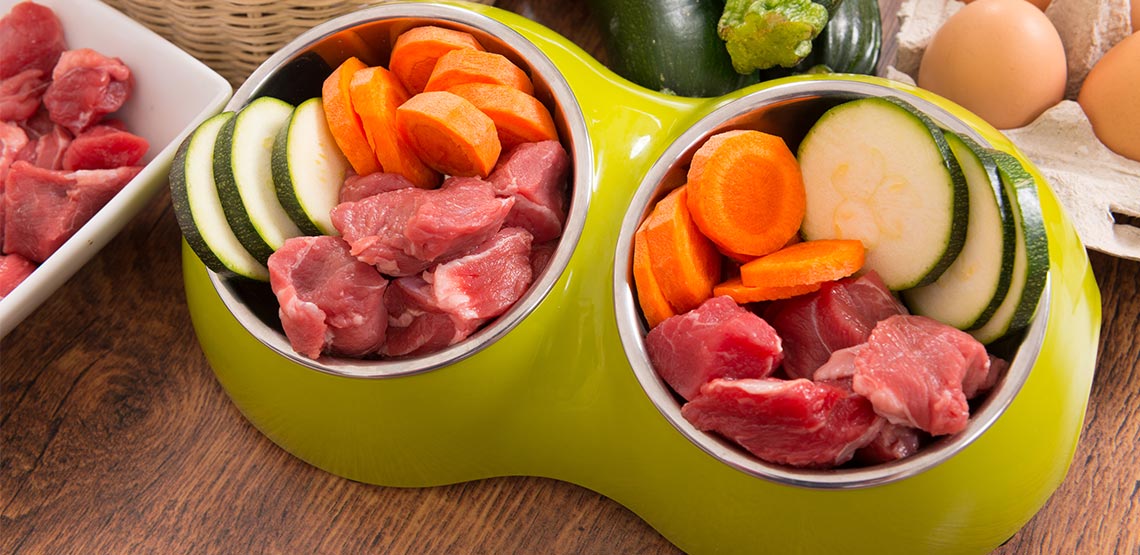Raw Food Diet for Dogs
Before any realistic article about raw dog food can begin, a little background should be given. It is generally accepted that raw dog food was originally fed to racing dogs and Arctic sled dogs. Then around 1993, Australian vet, Ian Billinghurst, introduced and promoted the idea to pet dog owners. He called his concept BARF ― catchy huh? Well it did market better than Biologically Appropriate Raw Food.
Taken individually, raw food ingredients ― like eggs or carrots ― will not supply dogs with their required daily nutrition. To be a healthy, performance-effective dog food, the mixture of uncooked ingredients must be properly proportioned and mixed. And make no mistake ― the food must be nutritionally balanced to meet the daily needs of the dog.
For instance, too low in energy then the dog loses body weight and gets sick. Too much energy then the dog becomes obese and also gets sick. Wrongly supplied micronutrients (vitamins, minerals, enzymes and amino acids) can adversely affect every cellular function and defense mechanism of the dog.
Those things will all lead to the dog suffering chronic sickness and death. And, we haven’t even gotten to the potential for bacterial contamination yet. No worries, we will.
Typically, the raw ingredients used are what are normally thought of as human foods. Ingredients like uncooked eggs, dairy, herbs, veggies, fruits, nuts and meat (including organs) may be used. Further processed meat meal, bones and bone meal are also commonly included in raw dog foods. Sounds good, right? Well, maybe, but maybe not. We’ll lay it out for you; then you can draw your own conclusions.
Okay, so that’s what raw dog food is in a nutshell. But, what are the benefits and downsides? What should you look for in a raw ration? What transitions from cooked to raw are needed? What does your vet say about raw diets? What kinds of raw dog foods are out there and are they safe? Are they economical? And lastly, should you buy commercially made or make your own?
Here's what to do know when it comes to a raw food diet for dogs.
Some of the Claimed Benefits
- Smaller, more frequent stools ― less constipation
- Cleaner, whiter teeth and better breath
- Healthier looking eyes, coats and skin
- Improved weight management
- More pep and less sleeping
- Fewer allergies
Some of the Claimed Downsides
- Initial diarrhea that may become chronic
- Chance of human and pet bacterial infection
- Risk of choking, broken teeth or other internal injury to dogs
- Unbalanced dog food ration leading to undernourishment and disease
What Should You Look for in Raw Dog Foods?
If you’re thinking about starting your new pup on a raw food diet, or transitioning an adult or rescue dog, then look for these things on the packaging label:
- Suggested feeding amounts
- The “use by” or expiration date
- How and where the ingredients are sourced
- The nutritional information or “proximate analysis”
- Whether the food is freeze-dried or fresh-frozen
- Recommended dog size/weight, age/health and activity level
If that information is not on labels, then you should not buy the product. Be aware that puppies are at risk of developing rickets or other serious disorders if the calcium:phosphorus ratio is incorrect. Other serious disorders may develop if other nutritional deficiencies are present or if the dog has serious health issues.
For example, a dog with a weak heart or pancreatitis will decline rapidly on a high-fat raw food diet
What Transitions, If Any, Should be Done?
Any time you change a dog’s diet you should gradually transition the dog into the new ration. This will help prevent diarrhea, vomiting, constipation, blocked bowels and other upsets. Usually a few days to two weeks is adequate for this, especially if you’re changing your dog from kibbles or canned food to the new raw diet.
Over the course of a few days, increase the weight of the new food as you decrease a like amount of the old feed. If there are label guidelines then you may want to follow them.
You should always discuss any diet changes in advance with your vet too. Your vet knows your dog’s health better than you or anyone else. They can give you the best advice on whether or not to feed a raw diet and how to start your dog on it.
Be aware that the new raw dog food may contain bones or large pieces of tissue that are a choking hazard. Never leave your dog unattended during the transition. And never leave a puppy alone to eat, regardless of the food type.
What Kinds of Raw Foods Are Available?
There are typically three choices of raw dog foods. These are:
- Fresh blends
- Frozen blends
- Freeze-dried blends
Of these, frozen blends are the most available for local shopping or for online ordering.
The ingredients typically range widely, so you need to be aware that you may not always get the same thing.
Some of the typical raw ingredient choices are:
- Meats: beef, buffalo, horse, llama, venison, elk, lamb, mutton, chicken, turkey, goose, salmon, menhaden, tuna, cod or other fish
- Fruits and vegetables: apples, bananas, mangoes, peaches, pears, pineapple, strawberries, blueberries, blackberries, raspberries, cantaloupe, cranberries, watermelon, green beans, peas, carrots, celery, pumpkin, squash, spinach, broccoli and cucumbers
- Dairy: cheeses, yogurt and cottage cheese
- Eggs: raw, powdered and ground shells
Are Raw Dog Foods Safe?
That depends on who you choose to believe. According to the Raw Pet Food Industry pundits and supporters, yes, the foods are perfectly safe. According to the FDA and many independent vets, no, these raw pet foods are not safe.
In 2018 and through May of this year, the FDA published 72 pet food recalls. Of those, 30% were due to either salmonella or listeria contamination of commercially made pet foods. E. coli and other bacteria can be present in raw foods as well, although that FDA report did not report those.
It should be pointed out that the real risk is to the people preparing the dog’s food more so than the dog. Contamination of counters, cutting boards, sinks, hands, etc. is common and the risk to people is large.
You May Also Like:
Related Search Topics (Ads):
Are Raw Dog Foods Economical?
Actually, no they are not when compared directly to the cost of cooked kibbles and canned foods. If one assumes the dog will be healthier, happier and live longer with fewer vet visits, surgeries, etc. then perhaps raw foods are economical.
The problem with that assumption is that it’s based solely on anecdotal reports. There is no hard data yet to prove that out. These dog rations are simply too new and scientific data simply doesn’t exist yet.
To Buy or Make ― That Is the Question
When it comes down to this, people should probably not make their own raw dog food. The simple truth is that most people do not have the nutritional background to support doing this. That means the pooch will likely be under- or over-nourished.
Then there is the whole potential for personal and household bacterial contamination. That is probably a train wreck waiting to happen. If you are dead set on switching to a raw dog food, then we recommend buying a commercial product.
In conclusion, the choice to feed your dog a raw food ration is yours. But, enter into this decision wisely. Talk it over with your vet first. Don’t base your decision on anecdotal hearsay or online promotional hype. And remember to be very sanitary when preparing this food in your home kitchen.

